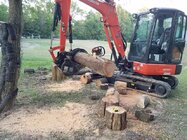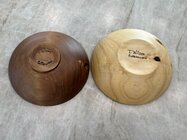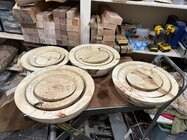I saw a local listing for free cottonwood and it turns out the man was taking down some large trees with trunk diameters up to 30-36”. While cottonwood is my least favorite wood to turn (I still struggle to get a totally tear out-free final cut and end up sanding more than other woods and my wife hates the smell and makes me shower after touching it) I am a sucker for large bowls and so when he said he could deliver the trunks to a field next to my house I thought it would be great to be able to restock my depleted stores of large bowl blanks.
I was surprised by how much was delivered. Here is a picture showing about 2/3 of what he brought (I had already cut up 6-7 trunks before this picture was taken):
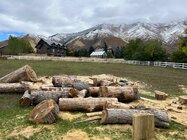
I have sealed about 25 bowl blanks in the 20-23” range and have them sitting in my barn on a cement floor with the quartersawn cuts stored on a rubber floor in an unused horse stall (partially visible in the background in the picture below).
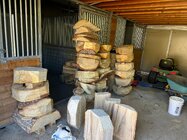
In the past I’ve had really good luck with cottonwood. I usually seal the blanks with one coat of anchorseal and store them in my basement shop - I have left many blanks there for years before coring them and have never had any checking or splitting. I don’t have room for all of these in my house so I’m wondering if I can just leave these in my barn until I get to them? Will the cold make them more likely to split? Winters here are snowy with temps in the 10s-30s throughout winter. My barn is not heated and has minimal insulation. Do I need to raise them off of the concrete floor?
I hope to finish making blanks in the next couple weeks then slowly rough out and core the blanks throughout the winter but it’s going to take me a while to get these all done. I don’t want to have all these blanks go bad and would appreciate any input from the group.
Thanks, Tom
I was surprised by how much was delivered. Here is a picture showing about 2/3 of what he brought (I had already cut up 6-7 trunks before this picture was taken):

I have sealed about 25 bowl blanks in the 20-23” range and have them sitting in my barn on a cement floor with the quartersawn cuts stored on a rubber floor in an unused horse stall (partially visible in the background in the picture below).

In the past I’ve had really good luck with cottonwood. I usually seal the blanks with one coat of anchorseal and store them in my basement shop - I have left many blanks there for years before coring them and have never had any checking or splitting. I don’t have room for all of these in my house so I’m wondering if I can just leave these in my barn until I get to them? Will the cold make them more likely to split? Winters here are snowy with temps in the 10s-30s throughout winter. My barn is not heated and has minimal insulation. Do I need to raise them off of the concrete floor?
I hope to finish making blanks in the next couple weeks then slowly rough out and core the blanks throughout the winter but it’s going to take me a while to get these all done. I don’t want to have all these blanks go bad and would appreciate any input from the group.
Thanks, Tom

